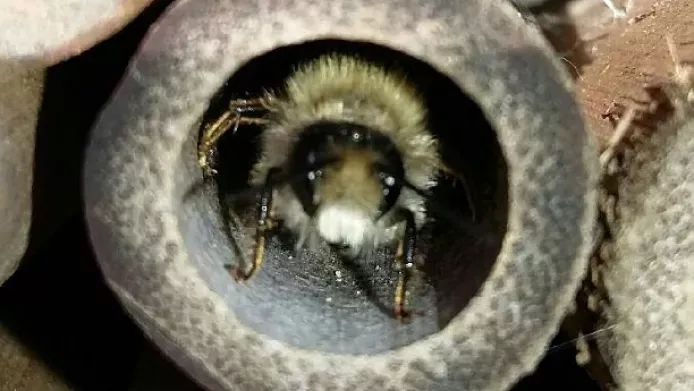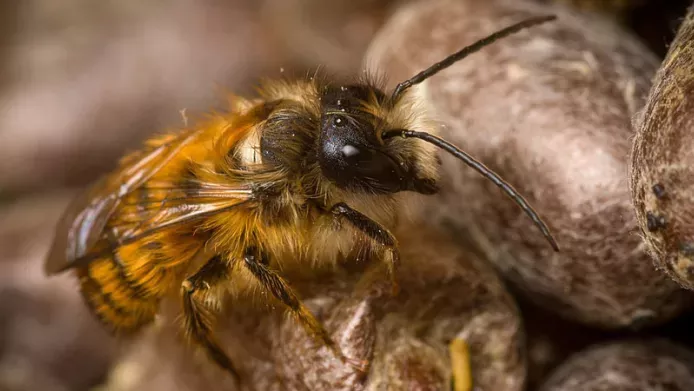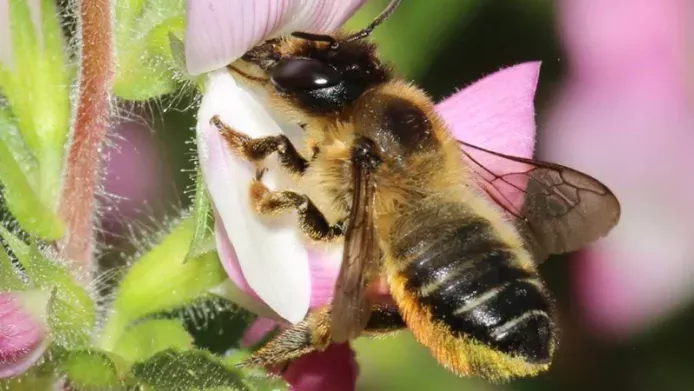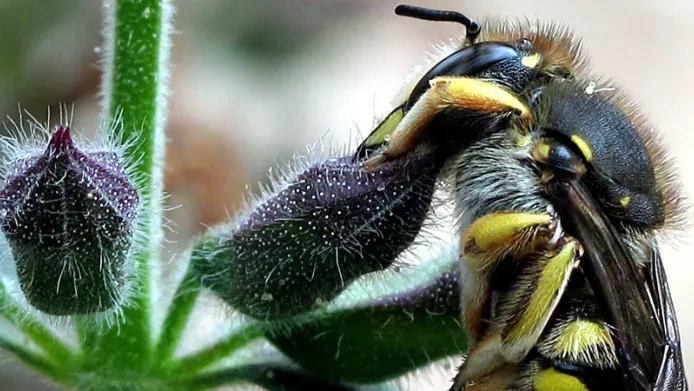When most people think about bees, they think about sociable honey bees or large, furry bumble bees.
In the UK alone, there are 267 species of bee. Over 90 per cent of them are not social and do not live in colonies — these are called solitary bees.

What’s so special about solitary bees?
- Solitary bees vary considerably in size, appearance and where they choose to nest. Roughly 70 per cent are called mining bees and nest in underground burrows. Bees that nest in houses are called cavity-nesting bees.
- Solitary bees do not live in colonies, produce honey or have a queen. While honey bees use wax to construct the cells inside their nest, different species of solitary bee use all sorts of materials to make their homes – for example, leaf-cutter bees use tiny leaf pieces within their nests, which might be in a hollow plant stem, dead wood or a crack in a weathered wall.
- They don’t have pollen baskets for carrying pollen, meaning that each time they visit a flower they lose far more pollen than social bees. This makes them much better pollinators: a single red mason bee is equivalent to 120 worker honey bees in the pollination services it provides.
- Solitary bees drink nectar directly from the flower and spend most of their time collecting pollen, which is mixed with a small amount of nectar as food for their young.
- They provide each larva with everything it needs, but they do not tend to the young as they grow and never get to see their offspring emerge.
Good to know
Solitary bees are nothing to fear! They are non-aggressive and do not swarm, so are safe around children and pets.

Solitary bees in the ecosystem
Solitary bees are easily overlooked, but they are known to pollinate plants more efficiently than honey bees.
They provide an essential ecosystem service, pollinating our crops and ensuring that plant communities are healthy and productive. Without them, mammals and birds would not have the seeds, berries or plants on which they depend; in fact, approximately one in three mouthfuls of food and drink require pollination.
Wildflowers provide essential resources of pollen and nectar for these busy workers and ample nesting opportunities in their dry, hollow stems.
Some bees, such as the harebell carpenter bee, are so dependent on a particular wildflower plant they cannot survive without it.
How to build a shelter for solitary bees
Each female solitary bee constructs and provisions her own nest.
Cavity-nesting bees require dry hollow tubes to lay their young.
Try making your own simple bee house by following our step-by-step guide with Hannah Grows:
What happens in the bee house?
Each female bee lays 20 to 30 eggs during her life.
When a bee finds a nest, she will collect materials to create the cell for her first egg: a ball of pollen stuck together with nectar for each larvae to eat until it develops into an adult bee.
She places the ball inside the cell and lays an egg on top, leaving space for the larvae to grow into an adult bee. She builds a partition wall and repeats the process until the whole tube is filled, leaving a space at the entrance of the tube empty before closing it off and moving on to another tube.
Females choose whether to lay male or female eggs; since males emerge a couple of weeks before the females, she lays all the females at the back and males at the front.
Solitary bees spend their early months hidden in the nest growing. They then spend the winter as a cocoon (or pupa) before emerging the following spring or early summer as adults. Once the adult bees have mated, the female looks for a suitable nest and the cycle repeats itself.
If you see solitary bees around your bee house, why not keep a record of:
- The number of holes filled and, if possible, the date each hole is filled.
- The material used – this will help you to identify the species.
- The date the cap is opened.
- Photos of the bees and capped holes.
How to identify solitary bees

Bees have four wings – whereas flies have two – and are generally hairier than wasps.
You might notice bees buzzing around your bee house. On wet days during the flying season (adult bees are most active in spring and summer), check inside the holes and you might see them sheltering from the rain.
Different species do appear at different times: the red mason bee is the first to emerge, so it is important in pollinating fruit trees, whereas leaf-cutter bees can be active as late as September.
Solitary bees vary massively but you can identify which ones are nesting by the materials they use to cap the tubes in the bee house. Whether they are using mud, leaves or fine hairs, the type of capping indicates the type of bee – and it’s possible you might have more than one type at the same time!
The three bees that you are most likely to find in your bee house are:
1. Red mason bee, Osmia bicornis (Osmia rufa)
With red/gingery hair, the females have small horns on their heads. They use mud to cap tubes in their nest. Active March–July.

2. Leaf-cutter bee, Megachile willughbiella
Broad head, large mandibles for cutting leaves and an upturned abdomen. They use leaves to build their nests. Active May–September.

3. Wool carder bee, Anthidium manicatum
Distinctive yellow and black markings on the flattened abdomen. Their building material of choice is fine plant hairs. Active June–August.
